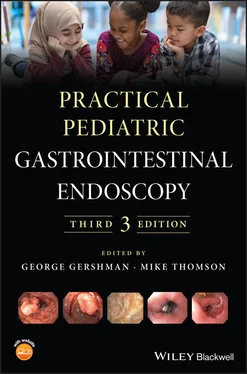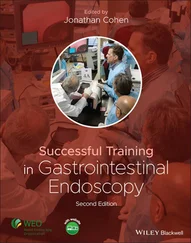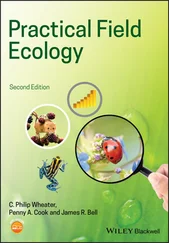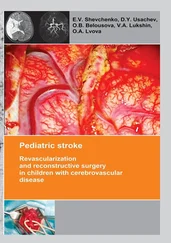The results of the national pediatric endoscopy pilot [6] were similar to the experience of the adult endoscopy units when they first started using the adult GRS in the UK [2] and to the Canadian adult endoscopy services when they first used the modified Canadian GRS [4]. It is important to highlight that this does not imply poor performance but is simply a starting point. This could occur because there may be areas where improvements are needed such as access to an electronic endoscopy reporting system or the unit is currently unable to measure, record, and review their performance. It did allow pediatric endoscopy units to identify what the quick wins for their unit were and in addition promoted collaboration between units, sharing of good practice documents and pathways and supported greater patient involvement in pediatric endoscopy services (P. Narula, unpublished results).
When the adult GRS was first implemented in 2004, the majority of the adult endoscopy units were achieving a level C or D. Following the implementation of the GRS and development of a professionally led peer‐reviewed accreditation process, there was an acceleration in service improvement and endoscopy units developed policies and processes to help meet the standards, resulting in a majority achieving the required level B across all standards [1,2]. A knowledge management system was also created which allowed services to share best practice pathways, policies, and guidelines [2].
Adult experience has shown that the endoscopy GRS allows for continuous quality improvement as the endoscopy units are regularly reviewing practice, looking for opportunities to further improve care and putting in measures to help achieve the highest standards of quality and patient‐cenetred care. The GRS also promotes benchmarking and collaborative working, allowing units to share solutions to common service problems or deficiencies. It is flexible in practice as it does not set specific outcomes but refers to current speciality guidelines and ensures adherence to these. As pediatric endoscopy services embed the use of the GRS in their clinical practice as a quality improvement tool, this will help not only to identify any gaps or improvements needed to deliver high‐quality patient‐centered care but also serve as leverage for clinicians to request the necessary support from their hospital management. It is envisioned that in time, quality assurance by a pediatric accreditation process will help sustain and accelerate service improvements triggered by the pediatric GRS.
See companion website for videos relating to this chapter topic: www.wiley.com/go/gershman3e
1 1 Stebbing JF. Quality assurance of endoscopy units. Best Pract Res Clin Gastroenterol 2011, 25, 361–370.
2 2 Valori R. Quality improvements in endoscopy in England. Techn Gastrointest Endosc 2012, 14, 63–72.
3 3 Sint Nicolaas J, de Jonge V, de Man RA, et al. The Global Rating Scale in clinical practice: a comprehensive quality assurance programme for endoscopy departments. Dig Liver Dis 2012, 44(11), 919–924.
4 4 MacIntosh D, Dube C, Hollingworth R, et al. The endoscopy global rating scale – Canada: development and implementation of a quality improvement tool. Can J Gastroenterol 2013. 27(2), 74–82.
5 5 William T, Ross A, Stirling C, et al. Validation of the Global Rating Scale for endoscopy. Scott Med J 2013, 58(1), 20–21.
6 6 Narula P, Broughton R, Bremner R, et al. Development of a paediatric endoscopy global rating scale: results of a national pilot. J Pediatr Gastroenterol Nutr 2017, 64, 25–26.
 FURTHER READING
FURTHER READING
1 Joint Advisory Group on GI endoscopy (JAG). Global Rating Scale. www.jagaccreditation.org
2 Joint Advisory Group on GI endoscopy (JAG). Global Rating Scale (GRS) – Paediatric. www.thejag.org.uk/AboutUs/DownloadCentre
8 Quality indicators as a critical part of pediatric endoscopy provision
Priya Narula and Mike Thomson
 KEY POINTS
KEY POINTS
Safe, efficient, technically‐competent endoscopy is only part of the story.
A child and family‐friendly environment, good pre‐procedure preparation, accurate documentation and clear and concise communication between team members is essential.
Appropriate after care and information with follow up complete an ideal endoscopic experience for a child and family.
High‐quality pediatric endoscopy occurs when a child or adolescent receives an indicated procedure safely and efficiently in an appropriate environment, with relevant and adequate communication and documentation occurring before, during and after the procedure among the involved health professionals and the patient and family or carer, a correct diagnosis is made or excluded and appropriate therapy is provided as indicated. Quality in endoscopy is not just limited to technical expertise but includes other elements such as clinical quality, quality of patient experience, workforce providing this service, and training, which can influence the overall quality of endoscopy provision.
A quality indicator or measure or metric can be used to compare actual performance against a standard defined by ideal performance or benchmark and enable potential quality improvement [1]. Clinically relevant measures should correlate with clinically relevant endpoints, be evidence based with demonstrable gaps in performance and be amenable to both measurement and improvement [1]. Quality indicators in adult endoscopy are well established and involve measures of structure, process, and outcome [2] ( www.thejag.org.uk). However, there is a limited evidence base for pediatric endoscopy quality indicators.
Quality indicators may be flexible as evidence and practice evolve. In the UK, identified quality and safety indicators have been used to underpin the respective items of the Pediatric Endoscopy Global Rating Scale (P‐GRS), a quality improvement tool launched in 2017 which, amongst other measures, assesses the extent to which the audit cycle has been applied to the quality and safety indicators ( www.bspghan.org.uk; www.thejag.org.uk). Suggested pediatric procedural quality indicators include procedure completion rates such as cecal intubation and terminal ileal intubation rates, appropriate diagnostic biopsies based on best evidence, adequate bowel preparation for colonoscopies, and safety indicators that relate to complication rates. These are auditable outcomes for which there is some evidence base to help recommend a minimum standard, for example, ileal intubation rates in pediatric colonoscopy. As confirmation or exclusion of inflammatory bowel disease is one of the main reasons for pediatric colonoscopy, ileal intubation is a clinically important and meaningful pediatric quality indicator compared to only using cecal intubation rates that are more relevant for adult endoscopists in the context of bowel cancer screening. Cecal intubation rates are generally recommended to be >90% ( www.thejag.org.uk). Reported ileal intubation rates in recent pediatric literature vary from 84% to 98% [3–5].
Читать дальше

 FURTHER READING
FURTHER READING







